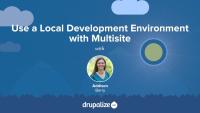This page is archived
We're keeping this page up as a courtesy to folks who may need to refer to old instructions. We don't plan to update this page.
Drupal provides a number of ways to work with multiple sites. This series gives an overview of those methods, and then teaches how to use the core multisite system. If you are interested in working with the Domain Access project instead of core multisite, you should look at the Introduction to Domain Access series.
Building one Drupal site is a fair amount of work in and of itself. But what about working with multiple Drupal sites? Sometimes you have a few sites that make sense together, either from a maintenance perspective, or due to an overlap in content or users. There are a number of different ways to approach this in Drupal, and which path you follow varies considerably depending on the exact use case you need to fulfill. In this lesson we'll get a good look at the problem multiple sites can pose, and list out some common use cases. Then we'll take a look at three different broad categories of solutions, with some specific architectural approaches. The rest of this series will walk through managing multiple sites using Drupal core's built-in multisite system.
If you are interested in working with the Domain Access project instead of core multisite, you should look at the Introduction to Domain Access series.
When working with domain names and getting a website to show up in your browser, it can be a little confusing to sort out which bits of the puzzle are where. You need to be able to properly configure the domain name server (DNS) so your browser can match up a domain name with a web server, and then make sure the Apache web server knows which files to direct that incoming domain name to. In this lesson we're going to walk through the process from the browser request to the website files. We'll take a look at the Apache documentation on virtual hosts (or vhosts) and discuss where to find this configuration. Then we'll take a look at some example vhost files to see what's going on in there.
Additional resources
Before we set up a multisite we need to understand how Apache and Drupal work together to deliver the site we intend. In this lesson we'll look at the documentation for Drupal multisites, and then discuss the way you need to set up your Drupal directories. We'll also review the workflow that Apache and Drupal go through to get the correct site displaying in the browser.
Additional resources
Multi-site - Sharing the same code base (drupal.org)
In this lesson we'll be building a simple university site, udrupal.com, with different areas, each with their own website: the main site, a news site, and an alumni site. The news site is simply a subdomain of the main domain name, news.udrupal.com, and the alumni site actually has its own separate domain name, udrupalalumni.com. To get this done, you're going to learn how to confirm the DNS is working for the domain names. That is, that they are currently pointing to the right server. Then we're going to configure an Apache vhost on our server so that Apache knows where to find our Drupal code base. We'll finish things up by installing our main Drupal site, udrupal.com.
Additional resources
With our domains and Apache configuration in place, we need to make sure all three sites can be installed at the different domains by creating our multisite directories in the sites folder. In this tutorial, we'll create the necessary Drupal site directories and settings files for the three sites so they are all running smoothly, check the domains and install the other two sites, and wrap up by changing the theme on the alumni site.
Before we get started, you should make sure you have two empty databases created for the two new sites we'll be installing.
In this tutorial we're going to be working directly on a server using the command line. You can feel free to use a GUI interface for your site, like an SFTP app or just your local machine file browser and editor apps. If you want to brush up on using the command line, you can check out our free Command Line Basics series.
If we want to do development work on the university multisite, we need to do a few things to have this run smoothly in a local development environment with all of those URLs. The sites.php file is going to let us define aliases for the site configuration folders in /sites. In this tutorial we'll explain why local development with multisite is tricky, and how to get it set up properly.
Additional resources
example.sites.php (api.drupal.org)
Drush is a really great tool for managing your Drupal site quickly and easily. If you don't already know about Drush, you should definitely check it out. When working with a multisite installation though, Drush can get confused if you don't give it all the information it needs. In this lesson we'll walk through how to use Drush properly with a multisite installation, covering both how to manage just an individual site and how to work with all of your sites at the same time.






